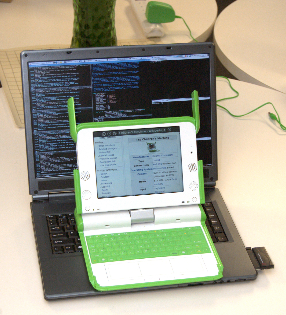Emulating the XO/lang-ja
- This is an on-going translation
{{anchor|Quick Start - [[LiveCd|LiveCD]}}
Contents
クイックスタート - LiveCD
多くの人にとっては、LiveCDを使う方法がSugarを試してみるのに最も簡単な方法です。最も簡単なのですが、リブートするとあなたが行った作業が消えてしまいます。
2007年7月の段階では、Live CDは3ヶ月以上も更新されていませんでした。その間ソフトウェアは大幅に進歩してしまったので、果たしてLive CDが更新されるまで役立つものかどうか定かではありません。
クイックスタート - エミュレーション
エミュレーションがSugarを試すもう一つの方法です。セットアップがやっかいですが、しかし作業の内容が維持されます。
- 現在、TamTamのサウンドがうまく機能しないみたいです。MitchellNCharity 13:16, 5 June 2007 (EDT)
クイックスタート(開発者向け)
エミュレーションでの開発はソフトウェア開発のための一つの代替手段です。
ここから最新イメージを入手してください。(add link to tinderbox) Emulating the XO/Quick Startに書かれているようにQEMUとカーネルアクセラレーションをインストールしてください。/Help_and_tipsの"Development"の項も参照のこと。
505が現在動作確認済みの最新版です。541以降のビルドも動きますが、しかしコラボレーション機能が壊れています(他のラップトップをブラウズすることができません)。
541と505の間の多くのビルド、例えば531, 529, そして525はブートしません。しかしながら50x以降のいくつかは動くみたいです。
概要
OLPCのソフトウェアを走らせる一つの方法はあなたのPCでエミュレータ(と呼ばれる種類のソフト)を使うことです。その他の方法についてはプログラミングを始めようをご覧下さい。
ノート:Category:Emulation and Help and tips
遊ぶだけなら、LiveCdを使うのもいいですし、クイックスタートも参考になります。
開発をするには、LiveCdやQEMU(クイックスタートにありますが、別のイメージを使います)、あるいはLiveDC以外の開発用イメージの一つを使うのも良いでしょう。その他の方法については、 Sugarをインストールするを試してみてください。プログラミングを始めようにそのあたりの比較が書いてあります。
一般的な開発手法はkqemuアクセラレータと共にQEMUを使うことです。基本的な事柄についてはクイックスタートをご覧下さい。
ちなみに私たちが開発をするときは、2,3のユーティリティプログラムと共に異なる.imgを用います。最新安定版が書かれているOS imagesのページをご覧下さい。
qemuの替わりに、VMwareを走らせることもできますし、Macではその他のやり方もあります。
イメージについてのユーザフィードバックにあなたの体験談をお寄せください。そこに一般的な仮想化に関する部屋というのがあります。
XOディスクイメージにおける制限があります。
LATEST-STABLE-BUILD(最新案定版)と最新のビルドとの違いは本物のXOを走らせている人々にとってしばしば話題の中心となります。エミュレーションでは、開発者は普通LATEST-STABLE-BUILDを使います。そして安定化版が古くなると、開発者以外もおそらくそれを使うべきでしょう。
XOと代替環境との比較
OLPCラップトップは特殊なハードウェアで、Sugarの走るスリム化されたRed Hat linuxを走らせます。しかしもしOLPCをあなたが持ってなかったら?その場合は2~3の方法と共に使える、いくつかの方法があります。
おすすめ
| プラットフォーム | 目的 | お勧め |
|---|---|---|
| Windows | 開発 | emulated xo disk image; or emulated Ubuntu with sugar-jhbuild; (or develoepr CD or LiveCD)?. (need your reports) |
| Mac | 開発 | emulated xo disk image; or emulated Ubuntu with sugar-jhbuild; (or developer CD or LiveCD)?. (need your reports) |
| Mac with Parallels | 開発 | Ubuntu 32-bitをインストールし, そしてUbuntu Linuxの上でSugarを動かす。/Macを参照のこと. |
| Ubuntu 32-bit | 開発 | Sugar with sugar-jhbuildとUbuntu Linuxの上でSugar |
| 32-bit linux | 開発 | Sugar with sugar-jhbuild |
| 64-bit linux | 開発 | qemu下でxoディスクイメージ; もしくはLiveCd once it gets updated (currently it's April) |
- I don't really believe the development option of Windows/Mac developer/live CD. I've not yet heard of it actually being used. They are months out of date (April). But Mcfletch said (in May) it's an option, so I added it. MitchellNCharity 09:19, 23 June 2007 (EDT)
Mcfletch It's probably no longer an option, Red Hat seems to have stopped releasing them. Even the developer's CDs are getting too old to be usable.
背景
| option | updated | sound? | camera? | library? | etoys? | R/W? | development software? | net? | comments |
|---|---|---|---|---|---|---|---|---|---|
| Installing Sugar | continuous | yes | yes? | yes? | yes | yes | your own | yes | On some platforms, it takes time and space (hours and ~3GB), but "just works". On others, it is quite difficult to install. |
| Installing Sugar, on a virtual 32-bit Ubuntu, running in an emulator (qemu, parallels, or vmware) | |||||||||
| LiveCd | April | yes(boot) yes?(qemu) | yes?(boot) no(qemu) | no | yes | no | toolchain, Gnome | yes? | Alternative Quick Start. Can both be booted from, and used in qemu. Problems: A. |
| XO disk images: | |||||||||
| LATEST-STABLE-BUILD http://olpc.download.redhat.com/olpc/streams/development/LATEST-STABLE-BUILD/ | |||||||||
| ...development-ext3.img | ~monthly | yes/B | no | yes | yes | yes | no | after config | Quick Start for getting a look at Sugar. |
| ...development-devel_ext3.img | ~monthly | yes/B | no | no | yes | yes | a little | after config | |
| LATEST http://olpc.download.redhat.com/olpc/streams/development/LATEST/ | |||||||||
| ...development-ext3.img | ~daily | yes/B | no | yes | yes | yes | no | after config | |
| ...development-devel_ext3.img | ~daily | yes/B | no | no | yes | yes | a little | after config | Good for new developers (requires some command-line comfort). |
| OTHER | |||||||||
| FC6+Sugar | April | yes? | ? | ? | no | yes | Full Fedora Softare Dev. | yes | 6GB (April version: no etoys) |
Key:
- library: A library of sample content is included (english version). Ie, pretty text to web browse without having to get network.
- R/W (writable): With an .img, you can save things between sessions. With a .iso, your environment is the same each time you start.
- development software: are development tools included?
- Net (network): does the network "just work" or "manual" steps are required?
Problems:
- A: LiveCd (April) on fc6 x86_64, kernel panics under kqemu. A squashfs problem.
- B: Tam Tam is silent (though EToys makes noise). Cause unknown.
Notes:
- re "does sugar-jhbuild support camera/mic?": "yes, if the camera uses v4l2 and 640x480, I'd suspect so." Can someone confirm this? (#olpc, now) MitchellNCharity 00:16, 2 June 2007 (EDT)
Doables:
- Remove LiveCd's "?" above.
- Find out what's going on with Tam Tam sound. It would be nice for the xo disk images to all be sound-yes.
- Add a microphone column? Reconsolidate sound/camera/mic into a H/W column?
Example step-by-step instructions
echo $COOKIE
3. On the xo, still as "su olpc", record the cookie: (First time only)
echo "add 10.0.2.2:1 . " PUT-THE-COOKIE-HERE
リンク集
- チュートリアル どのように動かせばいいかについてIBMがまとめたもの
